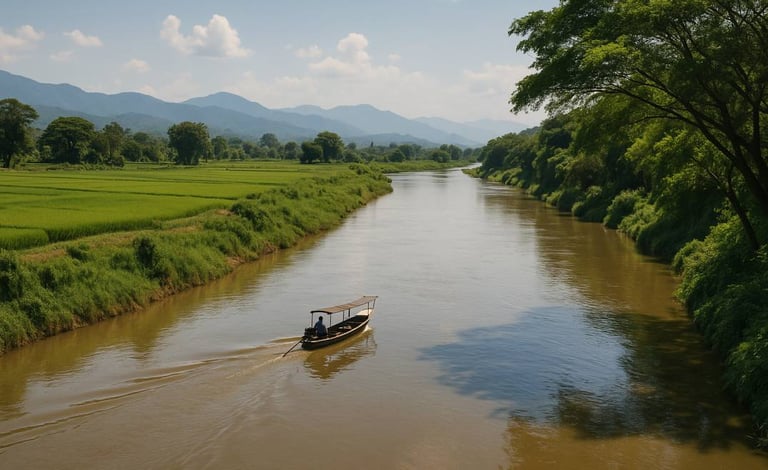Lao River, Chiang Rai: The Hidden Lifeline of Northern Thailand
Explore the Lao River in Chiang Rai, Thailand, a serene waterway nourishing local life, culture, and biodiversity. A peaceful, off-the-beaten-path escape awaits.
THAILAND
Arghyaraj Basu
6/19/20254 min read


Nestled in the picturesque Chiang Rai Province of Northern Thailand flows the Lao River, also known as the Mae Lao River. While often overshadowed by its much larger cousin, the Mekong, the Lao River holds its own unique charm, playing a vital role in the lives of local communities and the region's rich ecosystem.
Originating in the Phi Pan Nam Range, the Lao River embarks on a journey of approximately 206 kilometers, winding its way through Wiang Pa Pao, Mae Suai, Mae Lao, and Mueang Chiang Rai districts before gracefully emptying into the Kok River near Sum Pratu. It even lends its name to the Mae Lao District, a testament to its significance.
A Lifeline for Local Communities:
For centuries, the Lao River has been the lifeblood of the communities along its banks. Its waters nourish fertile agricultural lands, particularly rice paddies, supporting the livelihoods of countless farmers. The river is also a source of freshwater fish, providing a crucial protein source for local diets.
Beyond sustenance, the river fosters a close-knit community spirit. You'll often see locals engaged in daily routines along its shores – fishing, washing, or simply enjoying the tranquil flow. The river is intertwined with the cultural fabric, a silent witness to generations of traditions and daily life.
Biodiversity and Natural Beauty:
While specific biodiversity studies for the Lao River are less prominent than for the Mekong, it's safe to say that this tributary contributes significantly to the overall ecological richness of the northern Thai highlands. The region, generally, is known for its diverse flora and fauna. The Lao River, with its varied flow and surrounding landscapes, likely supports a range of aquatic life and provides habitat for birds and other wildlife. The lush greenery and serene environment along its course offer glimpses of unspoiled natural beauty.
Exploring the Lao River:
For those seeking an authentic and less-traveled experience in Northern Thailand, the Lao River offers a peaceful escape. While large-scale river cruises are more common on the Mekong, smaller, localized experiences along the Lao River could involve:
Local Boat Trips: Imagine a leisurely ride on a longtail boat, observing the rhythm of rural life along the riverbanks. This offers a unique perspective on the communities and their connection to the water.
Cycling and Walking: The areas surrounding the Lao River, particularly in districts like Mae Lao, offer beautiful landscapes for cycling and walking. You can explore charming villages, rice fields, and enjoy the tranquil atmosphere.
Cultural Immersion: Engaging with local communities, perhaps through homestays or village visits, can provide insights into their daily lives, traditions, and the cultural significance of the river.
Challenges and Conservation:
Like many rivers globally, the Lao River faces its share of environmental concerns. Upstream development, including hydropower projects, can impact water flow, sediment levels, and fish migration, potentially affecting downstream ecosystems and livelihoods. It's crucial to support sustainable practices and responsible tourism that prioritize the health of the river and the well-being of its communities.
The Lao River, though not as famous as some of Thailand's other waterways, offers a genuine and enriching experience. It's a reminder of the vital role rivers play in shaping landscapes, sustaining communities, and nurturing biodiversity. So, on your next trip to Northern Thailand, take a moment to discover the quiet charm and profound importance of the Lao River. You might just find a hidden gem.
Frequently Asked Questions about the Lao River (Thailand)
Q1: Where is the Lao River located?
A1: The Lao River, also known as the Mae Lao River, is located in Chiang Rai Province, Northern Thailand.
Q2: What is the significance of the Lao River to the local communities?
A2: The Lao River is vital for local communities, providing water for agriculture (especially rice paddies), a source of fish, and supporting the daily lives and cultural traditions of the people living along its banks.
Q3: Is the Lao River the same as the Mekong River?
A3: No, the Lao River is a tributary of the Kok River, which eventually flows into the Mekong River. They are distinct rivers, though connected.
Q4: What kind of activities can I do on or around the Lao River?
A4: Activities are generally more localized and less developed for large-scale tourism compared to the Mekong. You can enjoy local longtail boat trips, cycling or walking along its banks through rural landscapes, and engaging in cultural immersion with local communities.
Q5: Is it possible to take a river cruise on the Lao River?
A5: While major multi-day river cruises are typically on the Mekong, smaller, local boat trips are possible on the Lao River for a more intimate experience of the surrounding area.
Q6: What are the main towns or districts the Lao River flows through?
A6: The Lao River flows through Wiang Pa Pao, Mae Suai, Mae Lao, and Mueang Chiang Rai districts in Chiang Rai Province.
Q7: Are there any environmental concerns for the Lao River?
A7: Yes, like many rivers, the Lao River can be affected by upstream development, including hydropower projects, which can impact water flow, sediment, and fish populations. Sustainable practices and responsible tourism are important for its preservation.
Q8: Is the Lao River suitable for swimming or other water sports?
A8: While locals may use the river for daily activities, it's generally not promoted as a recreational swimming or water sports destination for tourists. Always exercise caution and observe local practices.
Q9: What is the best time to visit the Lao River area?
A9: The cool and dry season (roughly November to February) is generally the most comfortable time to visit Northern Thailand, offering pleasant weather for outdoor activities. However, the river offers beauty year-round.
